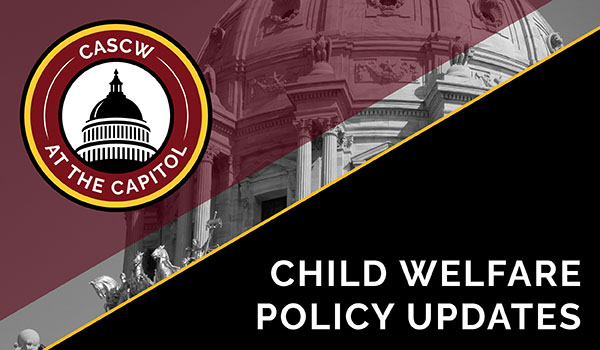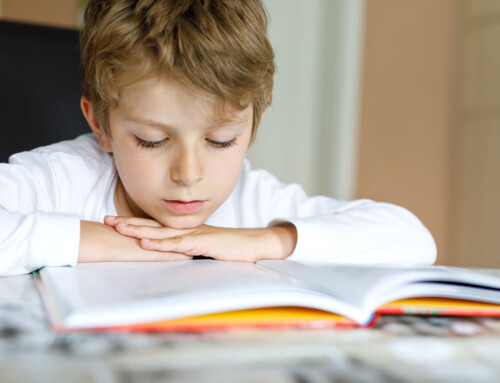 CACSW has compiled noteworthy state and national legislative developments below. If you don’t see a news item listed that you think should be, please send the bill and any additional information to Matthew Dooley, Outreach Graduate Assistant, at [email protected].
CACSW has compiled noteworthy state and national legislative developments below. If you don’t see a news item listed that you think should be, please send the bill and any additional information to Matthew Dooley, Outreach Graduate Assistant, at [email protected].
We want to hear from you!
CACSW is interested in highlighting the legislative projects of Minnesota child welfare professionals, advocates, and community groups. Please consider sharing your perspectives and priorities for the upcoming legislative session via this form for publication in future issues.
Opportunities and Events
9/17 DCYF Forums on Family First Spending
- Adopted from a DCYF Newsletter published 9/5/2024. Subscribe to DCYF newsletters.
The revised Family First Prevention Services Act allocation bulletin (#24-68-02R) outlines efforts related to the development and/or expansion of prevention services related to the implementation of the Family First Prevention Services Act (FFPSA). Attend the forum to learn how your county and/or Tribe can spend this allocation by the end of 2024 on areas such as transportation costs, housing, parent education, case management, and mental health.
- Tuesday, Sept. 17, 1 – 2 p.m. Register here.
For more information or questions regarding FFPSA allocation, please contact Sarah Barth.
9/18 DCYF Engagement Session on Adoption Belonging
Following closely on the heels of broader access to adoptee birth records, the Minnesota Department of Children, Youth and Families is seeking to engage with individuals and communities in creating a process to handle personal adoption belongings, such as photographs, letters, and family heirlooms. The Department will be holding quarterly engagement sessions on the topic of adoption belongings, both in-person and through zoom, with the first session on 9/18. Participants must be 18 or older.
- Wednesday, Sept. 18, 4 – 6 p.m. Register here.
Please direct questions or accommodation requests to Betsy Hodek.
10/8 MSSA Listening Session
The Minnesota Social Services Association hosts this free opportunity for constituents to connect with lawmakers on topics related to health and human services. The event will be held at the University of Minnesota-Duluth.
- Tuesday, Oct. 8, 12 – 1:30 p.m. RSVP by Sept. 30.
For more information, please email Michelle SanCartier.
Legislative Updates
New Legislation Database Provides Child Welfare Legislation from 2012 to Present
The National Conference of State Legislatures (NCSL) now has an online child welfare legislation database that includes all enacted legislation from 2012 to the present. NCSL updates the database weekly, and users can search by state and topic. Explore the database, including user guidance, on the NCSL website.
Access to Adoption Records Updates
Adopted from the MN Department of Health.
As of July 1, 2024, Minnesota law changed to allow access to original birth records by adoptees. Any Affidavit of Disclosure or Non-Disclosure submitted by a birth parent on or before June 30, 2024, to provide or restrict access to the record has expired. An adopted person’s access to original birth records is no longer determined by the disclosure preferences of the birth parent(s). To learn more on this change which affects adopted people, birth parents, adoptive parents and relatives, visit the MN Department of Health or Foster Adopt.
Parents as Teachers Program Expansion
Adopted from a DCYF Newsletter published 9/5/2024. Subscribe to DCYF newsletters.
DCYF has contracted with four agencies to either implement or expand the evidence-based service Parents as Teachers to support the goals of Minnesota’s FFPSA Five-year Prevention Plan, which is aimed at preventing children from entering foster care. Lutheran Social Services and Hennepin County will expand their PAT programming in St. Louis County and Hennepin County, respectively. Family Service Rochester and the Center for African Immigrants and Refugees (CAIRO) will become PAT affiliates. There are 11 PAT affiliate locations in Minnesota. The state is willing to connect these agencies with child welfare agencies to expand PAT as a prevention service in the future. To find an affiliate in your area, use the PAT Global Program Locator.
- For more information or questions regarding PAT, please contact Sarah Barth.
DCYF Reports and Bulletins
The Department of Children, Youth and Families released Children and youth missing from foster care: 2024 legislative changes to provide an update on the changes to the missing from care response as required by Minnesota Statutes, section 260C.212, subdivision 13.
DCYF also released the 2022 Maltreatment Report and the 2022 Out-of-home Care and Permanency Report. Takeaways from both reports can be found below:
Minnesota’s Child Maltreatment Report, 2022
This report gives an overview of the systems for responding to reports of child maltreatment in Minnesota, and presents detailed information on County, Tribal, and State statistics regarding out-of-home and permanency trends in 2022.
Completed Assessments and Investigations
- There has been a steady decrease in the number of alleged victims and completed assessments and investigations since 2018.
- A majority of reports (65%) were assigned to the Family Assessment (alternative response) path.
- Children from minority groups continued to be disproportionately represented in completed maltreatment assessments and investigations.
- 9% of completed assessments and investigations resulted in a child being placed in out-of-home care.
- 31 child deaths and 33 life-threatening injuries were determined to be the result of maltreatment. In 14 of the child fatality cases, the victim had previously been involved in a screened-in child protection case.
Minnesota’s Out-of-home Care and Permanency Report, 2022
This report details demographic information on children in out-of-home care (also referred to as foster care), and the statistics and trends related to efforts to promote the safety, permanency, and well-being of these children at the Tribal and County levels.
Annual Trends
- Children from minority groups were more likely than white children to be in out-of-home care.
- For the sixth straight year, Minnesota continued to see a reduction in the number of children who were in out-of-home care, as well as in children both entering and exiting care.
- For a second straight year, caretaker drug use has replaced neglect as the primary cause for child removal.
- Family reunification rates by race were fairly similar: African-American/Black (50.5%), American Indian/Alaska Native (48.1%), Asian/Pacific Islander (43.7%),
- Two or more races (49.7%), White (54.8%), Hispanic (52.1%).
- Children with disabilities and children under the age of 3 years old were disproportionately represented among children in out-of-home care.
All DCYF bulletins related to child welfare and similar topics can be found here.
